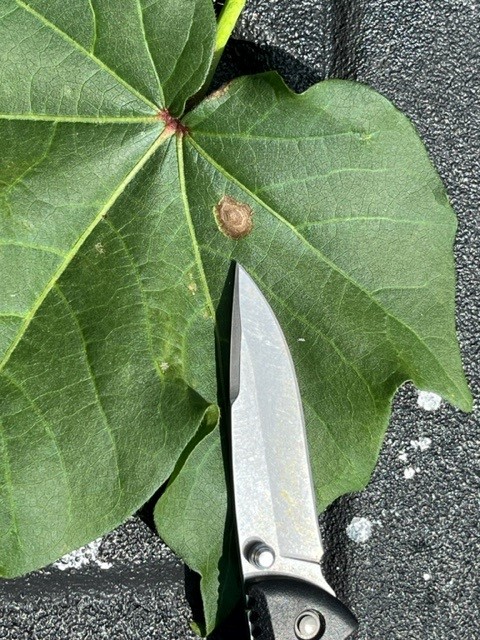Cotton Jassid Update (Phillip Roberts): Cotton Jassid or two-spot cotton leafhopper, Amrasca biguttula, is an invasive insect from the Indian subcontinent. It was first detected in the US in Florida in 2024 and we have currently detected the Jassid in 27 south Georgia counties (we are waiting for official identification but are confident this is cotton jassid). Cotton jassid is a potential pest of cotton as it requires management in cotton where the pest is native. The Florida Department of Agriculture and Consumer Services released a Pest Alert in December 2024 and provides good information on this invasive bug, see online at: https://ccmedia.fdacs.gov/content/download/117692/file/two-spot-cotton-leafhopper-pest-alert.pdf
Cotton Jassids are small leafhoppers, about 1/10 inch in length. They are sucking insects and feed on the underside of leaves. This insect typically infest edges and ends of fields (similar to whiteflies) and in most cases infestations are low. However, we need to be aware of this new potential pest. When scouting be sure you are 8-10 rows from edges or 30-40 feet from ends. To scout, turn an individual expanded main stem leaf from one of the top 5 nodes and count immatures on the underside of the leaf (see pic below). We cannot identify species of nymphs but adults are easily recognized by two black spots on the wings (see pic below). Plant injury includes yellowing of leaves on the outer edges or hopper burn or leaf puckering (see pics below). If you detect jassids in the field (I have observed the insect in a few fields in Bulloch County at low numbers – Bill Tyson) please contact your county agent for the most current information on thresholds and insecticide selection. This is an evolving situation and management strategies are subject to change.


- Cotton Jassid adult (left) and nymph (right). Images by Justin Odom


2. Cotton Jassid plant injury: hopperburn (left) and leaf puckering (right). Images by Jeremy Kichler

3. Jassid adult and numerous nymphs on underside of leaf. Image by Hunt Sanders
Cotton: I identified target spot in a few irrigated cotton fields this week in the county. Recent rain events, high humidity and good cotton growth is ideal for it and areolate mildew to start showing up. I have not seen any areolate mildew in any cotton field yet in the county, but the current weather we are having is ideal for it. Be sure to scout your cotton for target spot (Figure 1 & 2) and areolate mildew (Figure 3). Look for initial spots and mildew deep in the interior of the canopy. Please let me know if you identify areolate mildew in a Bulloch County cotton field as I am looking for a field to incorporate a cotton fungicide research trial.



Peanuts: White mold, white mold and more white mold. I have seen white mold showing up in peanut fields in Bulloch County within the last couple weeks. Make sure you are staying on schedule with your peanut fungicide program. The recent hot weather combined with the humid conditions is an excellent recipe for white mold. Also, the warm nighttime temperatures (above 75°F) of the past several weeks added fuel to the fire. Be sure to stay on a good fungicide program, tightening spray intervals where disease is becoming problematic and/or where there is concern.
The cooler weather this week has felt good and it will also slow the white mold activity down; however, when the temperatures increase the disease will be aggressive once again. Enjoy this cooler weather while it lasts, but be sure to stay on task with your peanut fungicide program.
